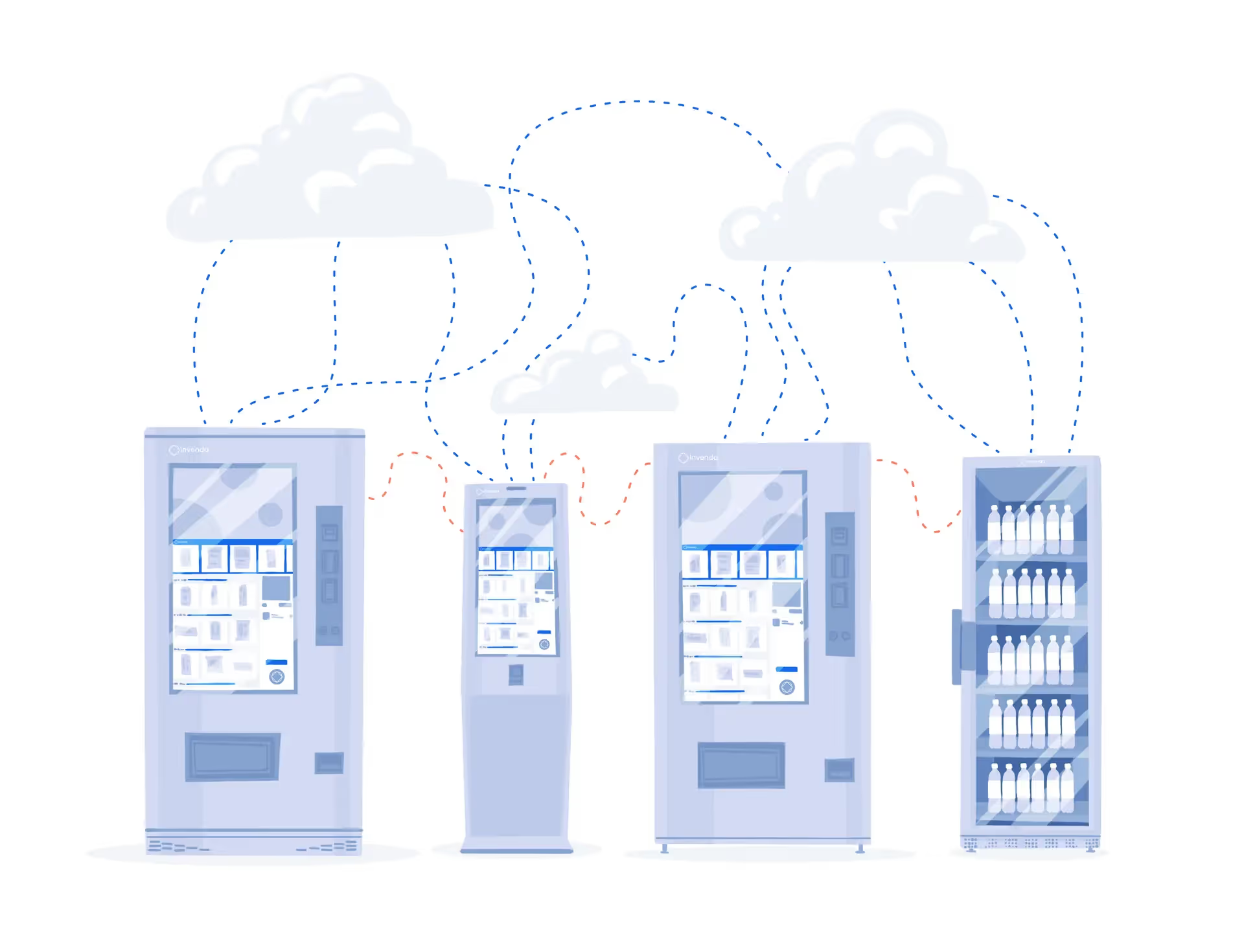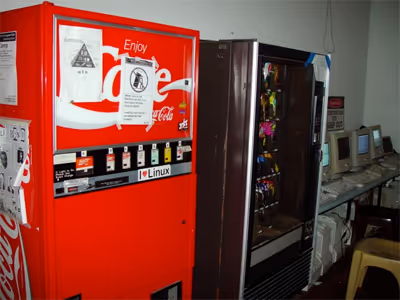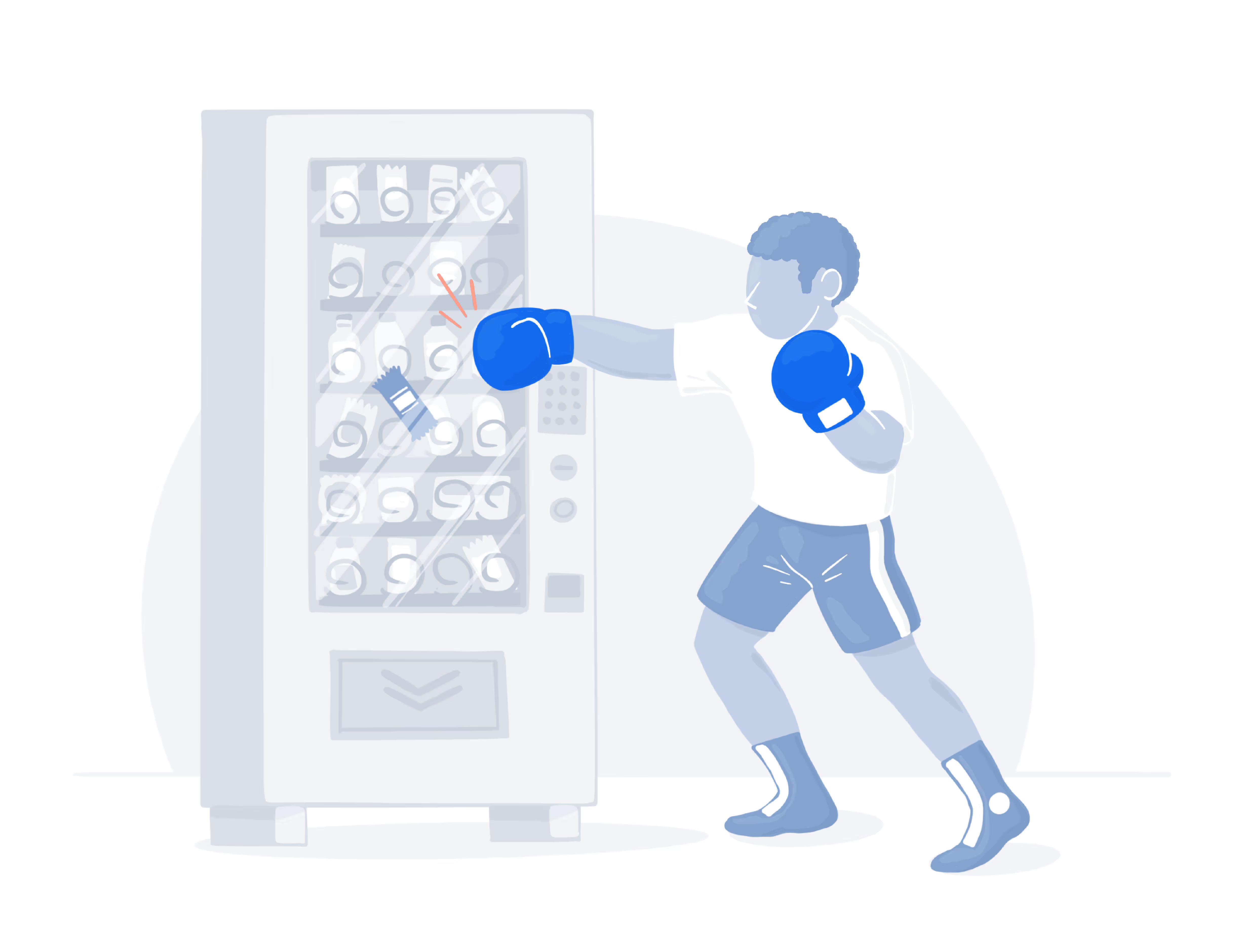
Gone are the days of constant manual checks, inefficient refilling visits, and merchandising based on guesswork.
Say goodbye to unappealing, half-empty glass vending machine fronts being kicked by frustrated consumers – a picture stubbornly imprinted in our collective memories – and say hello to sleek devices with large interactive screens.
In its mission to change the way the world shops, Invenda is ushering in the Internet of Retail (IoR). It’s a new era in automated retail, where devices are smart and connected, operations are streamlined, and consumers are treated to a frictionless shopping experience.
In this article, we’ll explain what IoR is and name the main reasons why it is the way forward in the automated retail industry.Getting the basics right
Before diving into the depths of the Internet of Retail, let’s float around a few terms we’ll need to define it.
Broadly speaking, automated retail is the use of technology to sell goods. Sometimes dubbed “unmanned” or “unattended” retail, it involves no or minimal human presence, effectively eliminating labor costs and human errors.
These self-service points-of-sale include devices like:
Historically siloed to selling FMCG from the basement parking lot and saddled with slow modernization, automated retail has been underutilized to the detriment of all parties involved: brands, operators, and consumers.
Even though it has always held exceptional possibilities for advanced technology – the first IoT device was a Coca-Cola vending machine built in 1982 – the industry has been slow to innovate. Yet, due to changing shopping habits and consumers’ demanding a more private and curated purchasing experience, the vending machine market has seen steady growth in recent years and is expected to grow to more than $28 billion by 2030.
To realize the full potential of this crucial sales channel, disrupting companies like Invenda are now using advanced technology to offer smart solutions, bringing a matrix of opportunities to collect data, drive ROI, and engage customers with improved user experiences, authentic cross-selling, gifting options, and targeted advertising. One of the most important aspects of that technology is the Internet of Things.

The first IoT device
What happens to former technology buzzwords?
In 2023, “the Internet of Things” can hardly be found on any buzzword lists while only a few years ago, it was all the rage. Well, the concepts they represent either slip into oblivion or become such a common part of reality that they simply lose their buzzworthiness.
“The Internet of Things” belongs to the former category. It is usually defined as a network of physical objects with sensors and software that exchange data over the Internet. Those objects are called “smart devices” and a large number of people in the world have at least one – their smartphone.
Interestingly enough, the first smart device in the world was the above-mentioned Coca-Cola vending machine. Born out of one student’s wish to know that a nice, chilled Coke will be waiting for him in the vending machine across the campus, the device was filled with microswitches and connected to the Internet (or its predecessor).
Today, technology has advanced so much that you can come across very peculiar smart devices, like a smart litter box, a smart baby monitor that alerts parents in real time when their baby’s diaper is full, a smart toilet, and smart snoring solutions.
What all these devices have in common is the ability to monitor different parameters and collect data that is analyzed in real time to identify trends and patterns. These insights are then used to streamline operations and ultimately increase the bottom line.
Apart from improving efficiency, cutting costs and enabling data-driven decision-making, IoT devices can also provide an enhanced consumer experience. Thanks to the data exchange that is at the core of IoT and real-time data analytics powered by AI and machine learning, consumers can now get a personalized shopping experience, tailor-made for them according to their shopping behavior, demographics and other factors. And experience sells.

What has that got to do with automated retail?
After the revolutionary Coca-Cola vending machine from 1982 proving that convenience and IoT go hand in hand, the automated retail industry went back to the metaphorical cave and remained dormant until very recently. Despite the obvious advantages of adopting modern technology, the industry where everything started ironically turned out to be a very late bloomer.
As a consequence, this valuable sales channel that caters to the needs of modern consumers like no other – providing convenience, control, and immediate gratification to the increasingly busy world, that puts brands in direct contact with consumers, and occupies prime retail locations, has chronically suffered from the lack of data and operational inefficiencies, not to mention the cultural stigma of being associated with rickety devices needing to be kicked for the product to be dispensed.
Now, companies like Invenda are changing that by offering smart solutions that finally take this unique channel to the next level and mark the start of the fourth industrial revolution in the antiquated world of vending. The Internet of Retail is the new era in retail, seamlessly connecting the physical with the digital.
Invenda’s IoR platform agnostically connects all automated retail devices, including vending machines, smart fridges, and micromarket kiosks. Together with Invenda Wallet, a download-free app for mobile shopping, it is an end-to-end solution transforming the self-service industry to fit changing consumer habits and the modern concept of ‘convenience’.
“We work with machine manufacturers to make their devices smart and then connect them to our IoR platform. It allows nimble management and maintenance of the machines, diversifying revenue streams, and gathering invaluable data in the style of online shopping. In addition, we have designed our very own vending machine which is made in Europe”, says Mark Crandell, Invenda’s Chief Commercial Officer.
Invenda’s clients report sales jumps of up to 60% thanks to a multi-product basket, various cross-selling and promotional features, dynamic pricing, and targeted advertising.
Devices are managed and monitored from a single easy-to-use dashboard, leading to a 30% reduction in technical interventions.
In an industry notorious for insufficient data, IoR sheds light on consumer behavior e-commerce-style – with comprehensive sales reports, demographic profiling, and touchscreen heat maps.
The 49-inch vending machine screens double as premium digital signage for DOOH advertising. They can run full-screen video ads for products sold in the machine or third-party ads – for a fee.
Thanks to attractive UIs, innovative features like gamification and personalization, and seamless payment via Invenda Wallet, consumers get the 21st-century level of convenience they have come to expect.
There is little doubt that, some day soon, the world is going to become smart (at least in the IoT sense of the world). At the same time, automated retail is proving its value and resilience by growing in spite of belated modernization. This sector too will eventually embrace the IoT technologies. But it would be smart to jump on the smart bandwagon now.